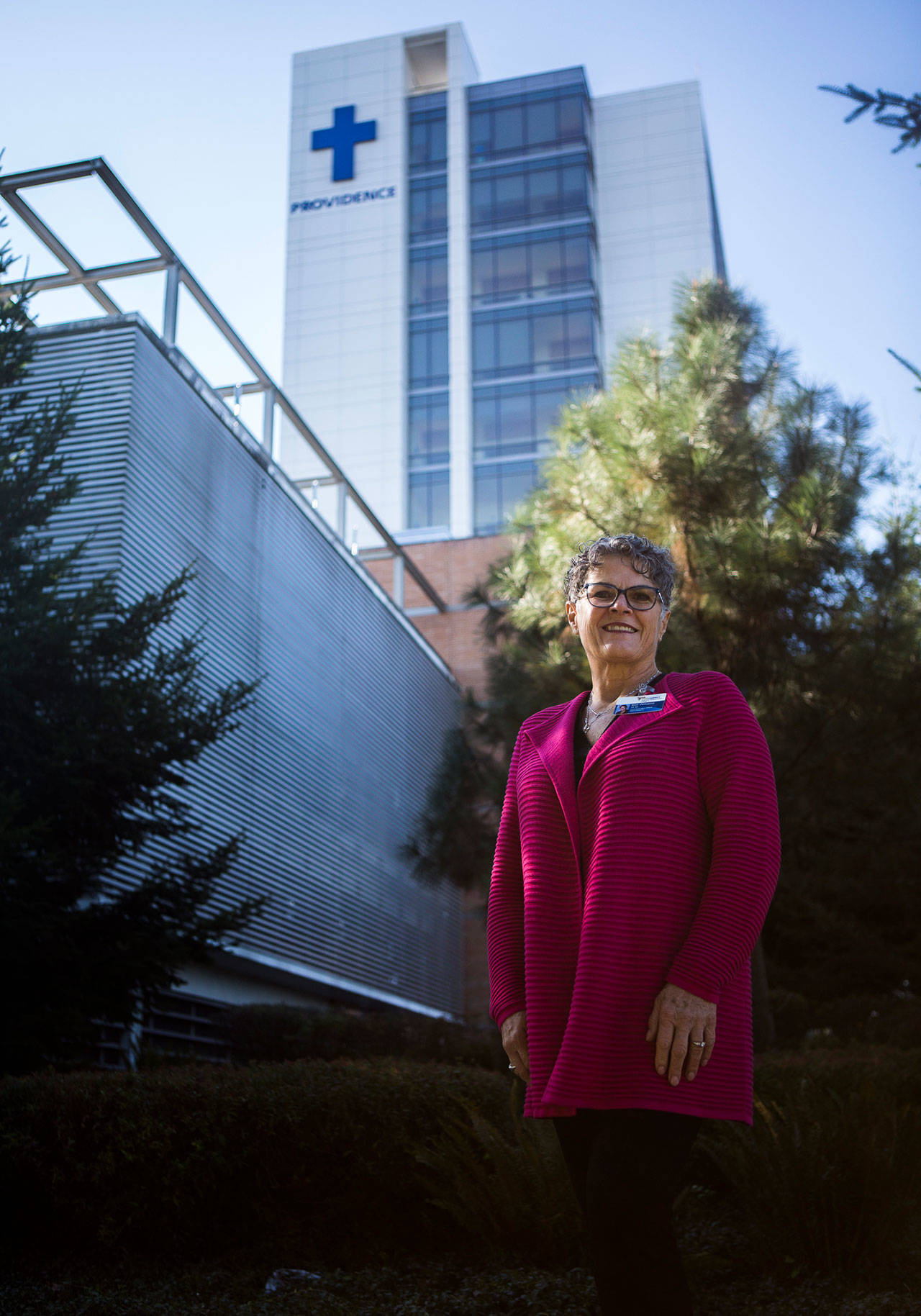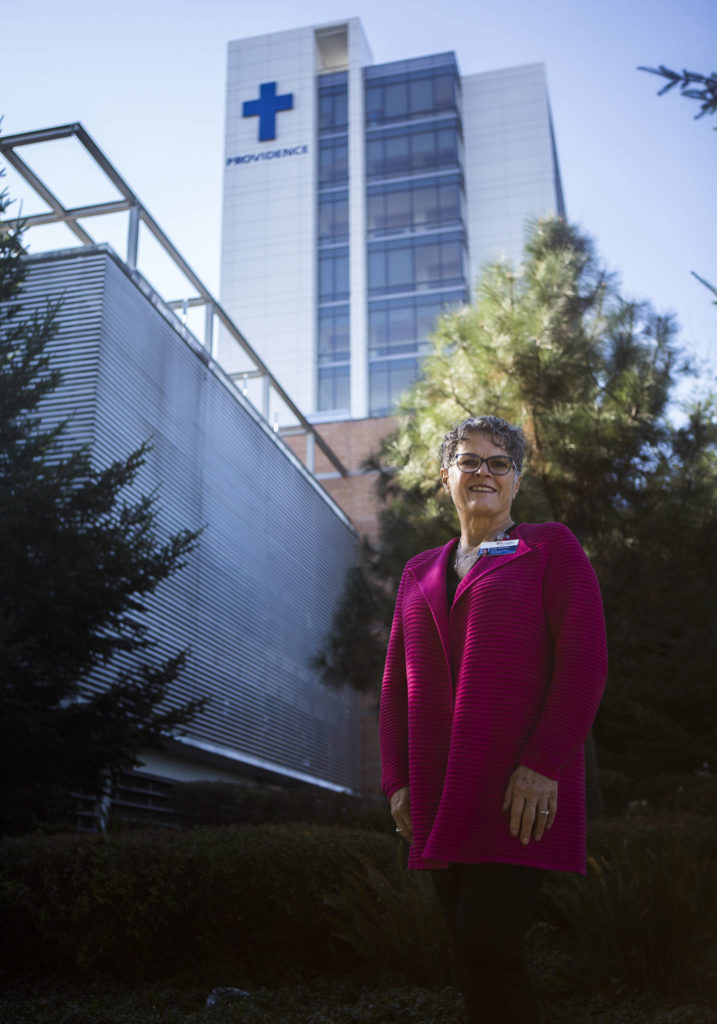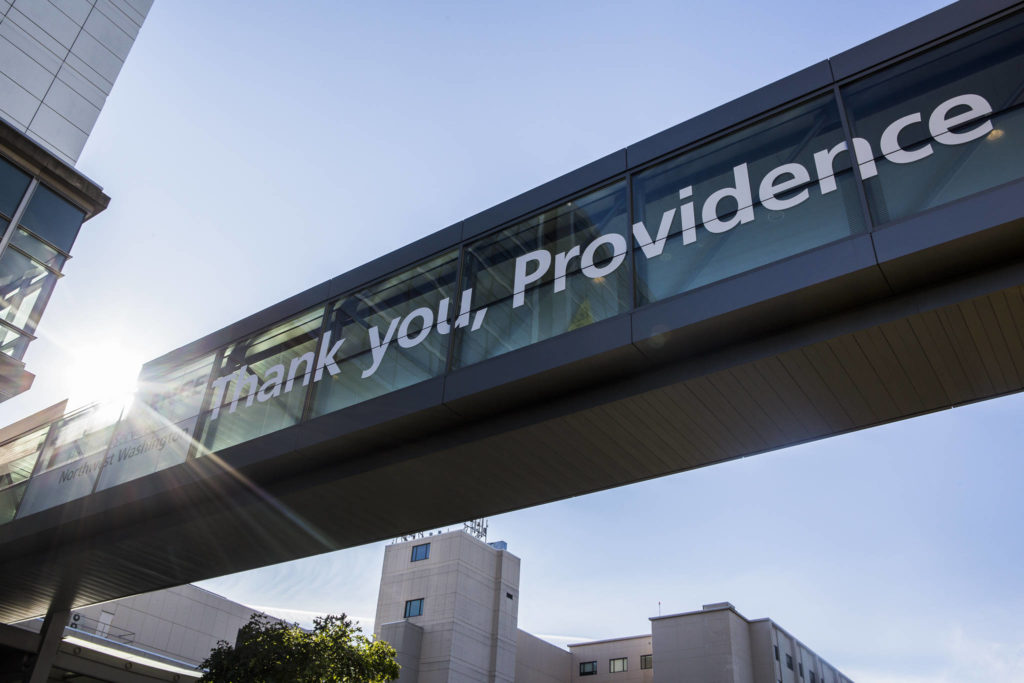EVERETT — A year ago, Compass Health launched a tele-health service. Six months in, the virtual platform was logging a respectable 500 appointments a month.
Then the coronavirus pandemic struck full-force in March, creating the need for social distancing and making some in-person visits risky.
By late spring, the number of virtual health care appointments had shot up more than tenfold — to 6,000 appointments a month.
“We trained 500 of our staff on the platform in a matter of weeks,” said Tom Sebastian, CEO of Compass Health. The behavioral health care provider serves patients who qualify for Medicaid, including 7,000 individuals and families in Snohomish County.
These days, about half of Compass’ services are delivered via the videoconference platform, Sebastian said.
The health care industry has added another tool to the doctor’s bag — virtual visits.
By the end of this year, nearly a quarter of all health care visits in the U.S. will have been virtual, compared to less than 10% in 2019, according to the 2020 State of Telemedicine Report.
It’s a similar story at Providence Regional Medical Center Everett and its area clinics where telemedicine visits have helped medical staff care for hundreds of COVID-19 patients recovering at home.
There, too, the number of tele-health visits skyrocketed, from 15 a day in March to 360 per day in April.
Those numbers declined after Gov. Jay Inslee eased the state’s stay-home restrictions in June. Still, Providence is averaging about 96 virtual visits per day.
Kim Williams, CEO of Providence Health & Services for Northwest Washington, is helping orchestrate the huge growth in virtual care. The Northwest division serves Snohomish, Skagit, Whatcom, Island and San Juan counties.
So far this year, telemedicine has helped the entire Providence St. Joseph network care for 10,000 patients who have tested positive for COVID-19, Williams said.
The health care network covers seven states: Washington, Alaska, Oregon, California, Montana, New Mexico and Texas.
“COVID home monitoring has helped us keep patients safe while reducing additional stress on hospitals, emergency rooms and front-line health care teams,” Williams said. “Additionally, this program helps to conserve personal protective equipment for caregivers and ensures hospital beds are available for patients who can’t be cared for at home.”
Patients who are well enough to stay home are given a thermometer and pulse oximeter and monitored by Providence’s tele-health clinicians.
“We can remotely monitor heart rate, temperature and blood-oxygen levels,” Williams said.
Medical staff can connect as needed with the patients via telephone or video.
Across the Providence St. Joseph network, which encompasses 51 healthcare facilities in seven states, the number of tele-health visits is on pace to reach 1.6 million by the end of the year, up from 70,000 in 2019.
The doctor will see you now
Patient response to virtual medical visits varies and depends on who’s on screen.
Only 28% of Americans surveyed say tele-health is comparable to an in-person visit, the telemedicine report said. The percentage goes up to 53% among respondents with chronic conditions who participate in more frequent virtual visits, the report said.
For Everett resident Gail Chism, virtual visits are a good option “as long as the doctor knows you.” Chism recently replaced an in-person appointment with a virtual visit.
“I had a doctor’s appointment that day but I wasn’t feeling well. I wasn’t sick, just tired,” said Chism, 75, whose underlying health conditions could make her more vulnerable to COVID-19.
Instead of canceling the day of, she requested a remote check-up.
“We had a virtual appointment and it was very thorough,” said Chism, who connected to the doctor with a home computer.
Julie Delaney, an Arlington first-grade teacher, prefers in-person visits. She meets twice a week with a therapist for help with anxiety.
The first virtual sessions with her therapist were awkward. The face-to-face screenings didn’t allow her or her therapist to pick up on body-language cues.
“Anytime we had a misinterpretation, it was usually during on-screen visits,” Delaney said.
Now, with restrictions eased, Delaney alternates between in-person and virtual visits.
“My best sessions are in person,” she said.
Telemedicine got a boost last spring from the Trump Administration when it expanded access to tele-health services through Medicare and Medicaid.
Before, federal subsidies only paid for tele-health on a limited basis — usually when a patient in a rural area was unable to travel for medical care.
It soon became clear that seniors and patients with chronic conditions such as diabetes and arthritis, who require frequent check-ins, could benefit from tele-health visits, the report said.
The report also noted that the universality of smartphones — 81% of Americans own one — makes it easier to reach communities that have traditionally lacked adequate health care.
In fact, about half of all virtual visits are conducted via a smartphone, followed by desktop computer and laptop link-ups.
It costs the same
Telemedicine’s quick ramp-up earlier this year caused some health care providers to puzzle over how to charge for virtual services.
Many turned to the Centers for Medicare and Medicaid Services for help setting rates.
According to the centers, virtual visits are considered the same as in-person visits and are paid at the same rate as regular, in-person visits.
Medical associations began to advocate along similar lines.
“You can bill audio-video or audio-only tele-health visits as if they were provided in-person,” the American College of Obstetricians and Gynecologists told members this fall.
As those rates align, consumers shouldn’t expect to pay less for a virtual visit.
However, patients may be able to see the doctor sooner if it’s an on-screen visit.
Instead of scheduling an in-person appointment weeks in advance, patients can “get in the queue for a virtual visit” and see someone more quickly, said Providence CEO Williams.
Family medicine, primary care, cardiology, pediatrics and behavioral health are among the most frequent types of visits that can be conducted virtually, said Williams.
“I did my annual exam virtually because I didn’t need anyone to lay hands on me,” Williams said of her own experience.
Telemedicine is helping Providence provide crisis care for patients experiencing mental health issues and to counsel patients with depression and anxiety, Williams said.
Dr. Camis Milam, a Compass Health psychiatrist, sees telemedicine as a critical tool in addressing mental health issues.
As the pandemic extends into the winter holidays, the rate of depression, drug, self-harm and drug-overdose rates are expected to climb, according to a September report by the Washington State Department of Health.
“People who’ve never experienced depression or anxiety are suddenly battling isolation and uncertainty on a daily basis,” Dr. Milam said. “Everyone is tired, emotionally spent. This is a dangerous time.”
“We’re seeing a lot of new folks who don’t necessarily have a mental illness that are being pushed to the brink,” she said.
Someone who needs to connect with a behavioral health professional doesn’t have to leave their home to make that connection, Milam said.
Compass also uses its tele-health platform to monitor children attending school from home. When schools closed, “the lives of special needs children were really disrupted,” Compass CEO Sebastian said.
Frequent virtual check-ins are helping bridge the gap. “It’s working effectively for them,” Sebastian said. “Kids have a much higher comfort level with technology.”
Here to stay
Virtual appointments aren’t expected to disappear when COVID-19 subsides.
More than 80% of patients who have sat for a virtual visit say they can envision incorporating tele-health into their regular health care regimen, the State of Telemedicine Report said.
One hurdle that Delaney, the Arlington teacher, faced at home was simply finding privacy.
With her husband and children working or attending school from home, finding a place where she could talk freely to her therapist proved challenging.
“I tried the closet a few times. I tried the garage. I went in the backyard. I sat in the car once,” said Delaney. “Now my husband knows on Wednesdays at a certain time he needs to leave.”
She still prefers face-to-face sessions with her therapist but sees the benefit of tele-health. Should she move out of the area or need a pep-talk while on vacation, help is only a few keystrokes away, she said.
“No matter where we are, I can get on the computer and talk to him,” Delaney said.
Janice Podsada; jpodsada@heraldnet.com; 425-339-3097; Twitter: JanicePods
Talk to us
> Give us your news tips.
> Send us a letter to the editor.
> More Herald contact information.



























